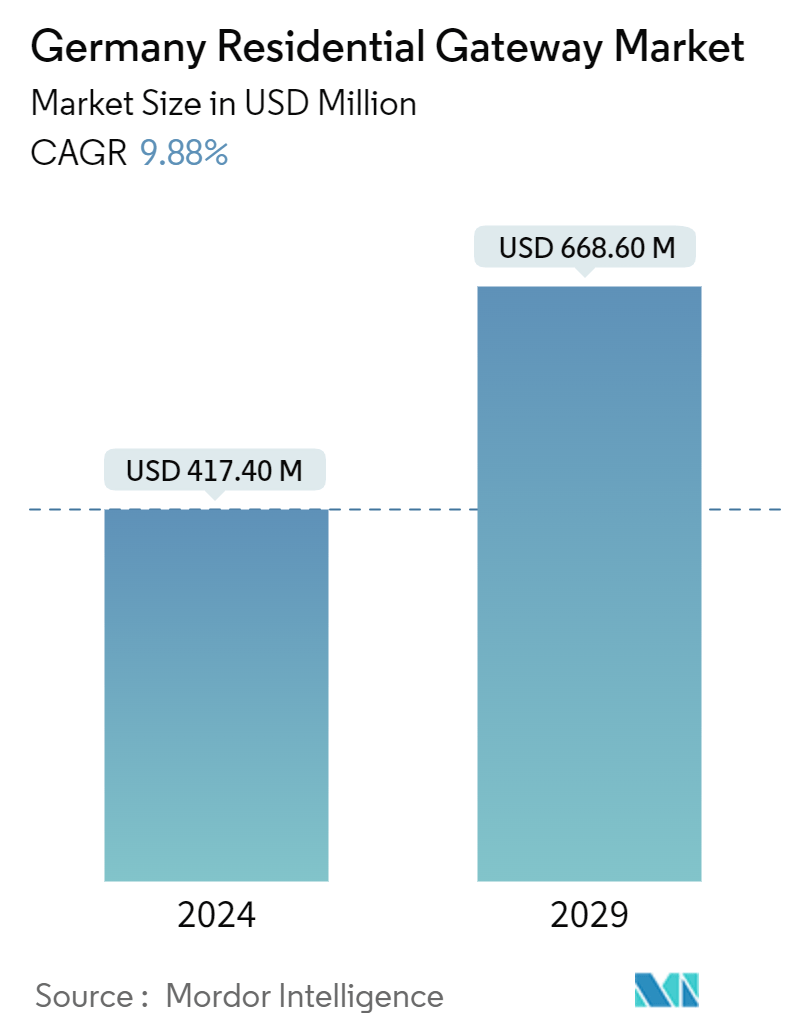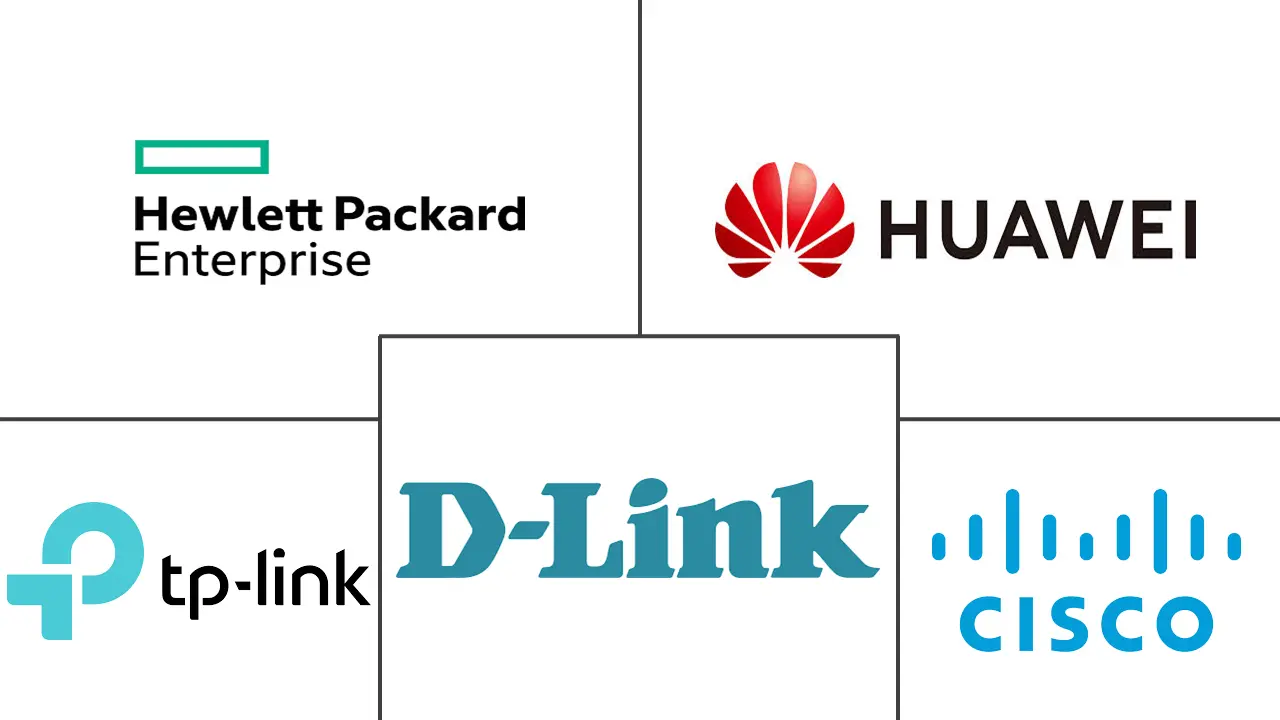Market Size of Germany Residential Gateway Industry

| Study Period | 2019 - 2029 |
| Base Year For Estimation | 2023 |
| Market Size (2024) | USD 417.40 Million |
| Market Size (2029) | USD 668.60 Million |
| CAGR (2024 - 2029) | 9.88 % |
| Market Concentration | Low |
Major Players
*Disclaimer: Major Players sorted in no particular order |
Germany Residential Gateway Market Analysis
The Germany Residential Gateway Market size is estimated at USD 417.40 million in 2024, and is expected to reach USD 668.60 million by 2029, growing at a CAGR of 9.88% during the forecast period (2024-2029).
Rising internet and broadband penetration among consumers in Germany is one of the major drivers of the German residential gateway market. The high penetration of the internet in the country's households has necessitated the demand for residential gateway devices, such as modems and routers, for seamless and reliable connectivity.
- With increased broadband penetration and technological advances in home networking, there is a considerable market demand for residential gateway devices in Germany. Households in Germany are increasingly populated with various digital devices, multimedia applications, networked appliances, voice and data communications platforms, entertainment systems, and much more.
- In addition, the rising demand for Internet connection sharing, simultaneous Internet access, and in-home audio and video streaming have driven the demand for residential gateway devices in Germany. Additionally, the shifting inclination toward smart homes among consumers in Germany has facilitated the utilization of residential gateway devices in households, thus supporting market growth.
- Moreover, the combination of work-from-home and smart home initiatives is creating significant demand for robust, reliable, and performant Wi-Fi environments in households across Germany, and residential gateway devices are gaining traction to deliver the necessary connectivity features that enable users to take advantage of networked homes. Market vendors are capitalizing on the opportunity and offering residential gateway devices on advanced Wi-Fi standards to deliver the requisite speed, reliability, and low latency to improve the performance of devices in home environments.
- Also, smart home devices have been increasingly adopted in Germany. Connected devices such as smart thermostats, security cameras, and voice assistants rely on a stable and high-speed internet connection, necessitating the use of advanced residential gateways.
- Germany is witnessing a growing number of personal data breaches and has become the second-largest country in terms of data breaches. Data breaches' escalating frequency and severity represent a formidable restraint for the residential gateway market. As the gateway serves as the primary entry point for data into a home network, its vulnerability to cyber threats becomes a paramount concern for consumers and manufacturers alike.
- The COVID-19 pandemic resulted in a significant uptake of residential gateway devices in Germany owing to prolonged lockdowns, which proliferated the demand for high-speed internet connectivity for online gaming, remote work, and streaming services. Post-pandemic, the rising demand for high-speed and reliable internet connectivity and the significant uptake of various consumer electronic devices, such as smart home devices, television (TV), laptops, and smartphones in the country's residential sector, are positively influencing the market’s growth in Germany.
Germany Residential Gateway Industry Segmentation
The German residential gateway market is defined by the revenue accrued through the sale of products and subscriptions of residential gateway devices, including modems, routers, wireless access points, network switches, etc., and associated services such as managing Wi-Fi services to consumers in Germany.
The German residential gateway market is segmented by offering type (modem, router, extenders and repeaters, network switch, other devices (wireless access point, VoIP analog telephony adapter, fiber ONT, etc.), managed Wi-Fi services), and connection type (digital subscriber lines (DSL), ethernet cable, fiber cable). The market size and forecasts are provided in terms of value (USD) for all the above segments.
| Overall Market Estimates and Forecast | |
| Overall Market Estimates and Forecast - Value in USD Million | |
| Overall Market Estimates and Forecast - Device Volume in Million Units |
| By Offering Type | |
| Modem | |
| Router | |
| Extenders and Repeaters | |
| Network Switch | |
| Other Devices (Wireless Access Point, VoIP Analog telephony adapter, Fiber ONT, etc.) | |
| Managed Wi-Fi Services |
| By Connection Type | |
| Digital Subscriber Lines (DSL) | |
| Ethernet Cable | |
| Fiber Cable |
Germany Residential Gateway Market Size Summary
The Germany Residential Gateway Market is experiencing significant growth, driven by the increasing penetration of internet and broadband services across households. This surge in connectivity demand is primarily fueled by the proliferation of digital devices, smart home applications, and the need for reliable, high-speed internet for activities such as online gaming, remote work, and streaming services. The market is characterized by a diverse range of residential gateway devices, including modems and routers, which are essential for facilitating seamless connectivity in networked homes. The shift towards smart home solutions and the combination of work-from-home trends have further amplified the need for advanced residential gateways that can support multiple devices and provide robust Wi-Fi environments.
Market players in Germany are actively innovating and expanding their product offerings to meet the evolving demands for high-speed and reliable network connectivity. The introduction of advanced Wi-Fi standards, such as Wi-Fi 6 and Wi-Fi 7, by major vendors like TP-Link, D-Link, and AVM GmbH, is a testament to this trend. These innovations are designed to enhance the performance of home networking devices, supporting a wide array of applications from 4K streaming to AR/VR gaming. Despite the positive growth trajectory, the market faces challenges, including concerns over data security and the frequency of data breaches, which underscore the importance of secure residential gateway solutions. Overall, the German residential gateway market is poised for continued expansion, driven by technological advancements and the increasing demand for high-speed internet connectivity.
Germany Residential Gateway Market Size - Table of Contents
-
1. MARKET INSIGHTS
-
1.1 Market Overview
-
1.2 Analysis of Macro-Economic Scenarios
-
1.3 Regulatory Landscape Related to the Telecom Industry in the Country
-
-
2. MARKET SEGMENTATION
-
2.1 Overall Market Estimates and Forecast
-
2.1.1 Overall Market Estimates and Forecast - Value in USD Million
-
2.1.2 Overall Market Estimates and Forecast - Device Volume in Million Units
-
-
2.2 By Offering Type
-
2.2.1 Modem
-
2.2.2 Router
-
2.2.3 Extenders and Repeaters
-
2.2.4 Network Switch
-
2.2.5 Other Devices (Wireless Access Point, VoIP Analog telephony adapter, Fiber ONT, etc.)
-
2.2.6 Managed Wi-Fi Services
-
-
2.3 By Connection Type
-
2.3.1 Digital Subscriber Lines (DSL)
-
2.3.2 Ethernet Cable
-
2.3.3 Fiber Cable
-
-
Germany Residential Gateway Market Size FAQs
How big is the Germany Residential Gateway Market?
The Germany Residential Gateway Market size is expected to reach USD 417.40 million in 2024 and grow at a CAGR of 9.88% to reach USD 668.60 million by 2029.
What is the current Germany Residential Gateway Market size?
In 2024, the Germany Residential Gateway Market size is expected to reach USD 417.40 million.

